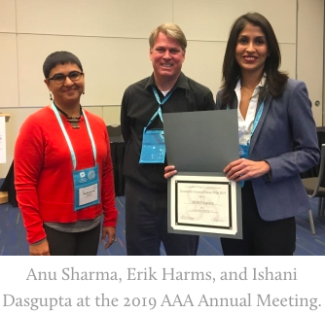
Ishani Dasgupta (PhD Candidate, University of Pennsylvania) was awarded APLA’s 2019 Graduate Student Paper Prize for her paper, “The Burning Body and the Withering Body: Embodied Resistance Practices in the Tibetan Community.” Ishani recently spoke with Randi Irwin (Casual Lecturer, University of Newcastle, Australia) about her award-winning paper, writing, and fieldwork, more broadly.
Randi Irwin: Congratulations on receiving the APLA 2019 Graduate Student Paper Prize for your paper, “The Burning Body and the Withering Body: Embodied Resistance Practices in the Tibetan Community.” Can you tell us a bit about the paper?
Ishani Dasgupta: Sure. My paper considers how embodied protests, like self-immolations and hunger strikes unto death, connect stateless Tibetans through a shared history of loss, articulated through a rhetoric of pain. I show that these engender a repertoire of protest which does not end with the action of the protestor; instead, they are extended by the community through processes of mourning, mobilization and memorialization which are undertaken both in exile and in Tibet, although they manifest differently across the two geopolitical spaces. Through these practices and vocabularies of resistance a transnational citizenry reiterates their commitment to the deterritorialized Tibetan nation. In this paper, I draw out a genealogy that links self-immolations, mostly occurring in Tibet, to hunger strikes in exile, less through the similarity in their form, and more through the shared practices that develop around them and the grassroots mobilization that emerges in their wake. The two forms are linked through the protestor’s centrality in the repertoire, due to her volition to die for the cause.
Self-immolations are a tremendously hard topic to write about, because articulation through language, particularly scientific language, effaces the excruciating bodily pain, the tremendous strength of will required, and the affective experience of community that they engender. I tried to place my ethnography at the heart of the paper, focusing on what the protest means for the community of deterritorialized Tibetans, what sort of practices, perspectives, and sentiments it invokes, because that was something I was witnessing. During my fieldwork, self-immolations were a part of everyday nationalistic discourse; it existed in images, in memories, in statues and photos; in Tibetan news, in prayers and speeches, in processions; and in expressions of identity, art and poetry, and in debates, dinner table conversations and even through black humor. My work amidst the exile community exposed how expansive these protests were for the Tibetan community that has to battle political marginalization, statelessness, and precarity...
Read the full interview: here.
